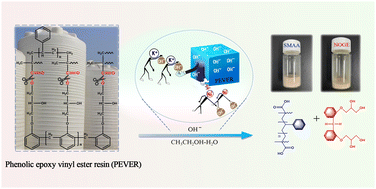Affinity of K+ to organic matter promotes reactions: degradation of super stable phenolic epoxy vinyl ester resin to value-added chemicals†
Abstract
As a kind of super stable thermoset resin, phenolic epoxy vinyl ester resin (PEVER) is widely applied as a solvent and corrosion resistant material. However, its highly cross-linked three-dimensional network challenges its degradation and recycling. In this study, we report an efficient catalytic system of KOH/C2H5OH–H2O to degrade PEVER under a mild reaction condition of 160 °C. It is discovered that the efficiency of KOH for degrading PEVER resulted from the high affinity of K+ to PEVER. Besides the resin, K+ shows good affinity to other organic substances, such as ethyl acetate, toluene, and petroleum ether, and it surpassed largely Na+ (NaOH) in the affinity to organic substances. The NMR and FT-IR characterizations indicated the degradation of PEVER via the hydrolysis of ester bonds, by which high value-added copolymer of styrene and methacrylic acid (SMAA), potassium salt of SMAA (SMAA-K), and novolac glycidyl ether (NOGE) were obtained. SMAA-K can be used as an interface modifier owing to its surface activity. The modified filter paper prepared by SMAA has high hydrophobicity. NOGE can be recycled to prepare a new polyurethane material. This study provides a new strategy for the chemical degradation and recycling of thermoset PEVER waste.



 Please wait while we load your content...
Please wait while we load your content...